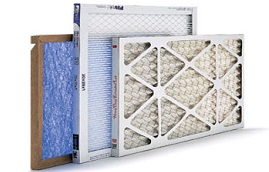When we make the decision to invest in an air conditioning system to improve the comfort levels in our home we have a number of options to consider. It’s imperative to choose the right size of system to suit the needs of our property. Is a programmable thermostat a better choice, when compared to a traditional unit? One of the key decisions that is often overlooked is the kind of air filter that will be used in the system. This is a key point, especially for people with allergies and respiratory illness. There are a number of options available, let’s take a close look at them so that you can make an informed decision.
The High Efficiency Particulate Air (HEPA) Home Air Filter:
The HEPA filter is the top filtration product for both the Occupational Safety and Health Administration and the Environmental Protection Agency. A HEPA filter can remove almost 98% of all pollutants from the air coming into your home. They are most often used in larger public buildings with an emphasis on health, such as clinics and hospitals. Obviously, these filters are a fantastic option for people suffering from allergies and respiratory issues. In these cases, a whole home HEPA air filtration system is a recommendation often offered by home cooling experts.
The High Efficiency Home Air Filter:
This is the next step down from the HEPA filter, but it can still remove around 85% of the pollutants from the air in your home. Those with milder allergic issues will gain noticeable relief from their symptoms. This kind of filter, as the name would suggest, can also help your HVAC system by making it more efficient. This has the added benefit of lowering your energy bills, which make this a great investment.
The Pleated Media Home Air Filter:
This is often referred to as the standard home air filter, and it is easily found at many home improvement stores. These filters are cheaper, but they need to be replaced every 30-90 days. This is a far shorter lifespan compared to HEPA and high efficiency filters that have to be changed annually. These filters eliminate almost 45% of the pollutants in the air, but this is dependent on the number of pleats in the air filter. More pleats equal a better air flow and cleaner air, but they are generally more expensive.
The Basic Fiberglass Home Air Filter:
This is the most basic type of home air filter that you would find in an AC system. This filter will not improve the indoor air quality at all, and no pollutants are removed. These filters are essentially used to shield the AC equipment and protect it from larger harmful particles that could cause damage. As such, they are helpful for the operation of the system, but they have no additional health benefits. Of course, the makes this kind of filter very cheap and then can usually be purchased at a $1 each.
In Conclusion:
All four of these air filter types play a vital role in the operation of your AC system. They should always be changed when necessary to keep the air flowing efficiently. The main difference between them is the amount of pollution removed from the air and the subsequent increase in cost to do that.
